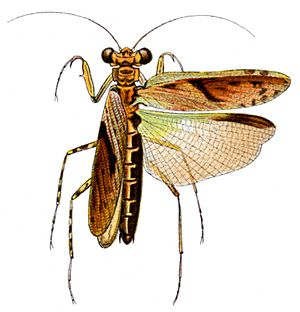Amorphoscelis elegans facts for kids
Quick facts for kids Amorphoscelis elegans |
|
|---|---|
 |
|
| Scientific classification | |
| Synonyms | |
|
Amorphoscelis elegans is a special kind of insect known as a praying mantis. It lives in parts of West Africa, including countries like Ghana, Guinea, Togo, and Equatorial Guinea, especially on an island called Bioko. This mantis was first officially described in 1913.
Contents
What is a Praying Mantis?
Praying mantises are fascinating insects. They get their name from the way they hold their front legs. These legs are bent and held together, looking like they are in prayer. But don't be fooled! These "praying" legs are actually very strong and are used for catching food.
Amazing Hunter Legs
The front legs of a mantis are specially designed for hunting. They have sharp spines that help them grip their prey. When an insect comes too close, the mantis can snap its legs shut incredibly fast. This makes it very hard for its meal to escape.
Masters of Disguise
Many mantises are camouflaged, meaning they blend in with their surroundings. They can be green like leaves or brown like twigs. This helps them hide from predators and also allows them to sneak up on their prey without being noticed.
Where Does Amorphoscelis elegans Live?
Amorphoscelis elegans is found in tropical and subtropical areas of West Africa. These regions have warm climates and plenty of plants, which are perfect for mantises.
African Homes
- Ghana: A country in West Africa with diverse habitats.
- Guinea: Known for its forests and savannas.
- Togo: A smaller West African nation.
- Equatorial Guinea: This includes the island of Bioko, where Amorphoscelis elegans has been found.
These areas provide the right environment for this mantis to find food and shelter.
What Do Praying Mantises Eat?
Praying mantises are carnivores, which means they eat other animals. They are excellent predators and play an important role in their ecosystems.
Insect Eaters
Their diet mainly consists of other insects. They will eat:
- Flies
- Crickets
- Moths
- Grasshoppers
Sometimes, a larger mantis might even catch small lizards or frogs! They wait patiently for their prey to come close, then strike quickly.
Life Cycle of a Mantis
Like many insects, praying mantises go through different stages in their lives.
From Egg to Adult
- Eggs: Female mantises lay their eggs in a foamy case called an ootheca. This case protects the eggs from bad weather and predators.
- Nymphs: When the eggs hatch, tiny mantises called nymphs emerge. They look like small versions of adult mantises but don't have wings yet.
- Molting: As nymphs grow, they shed their outer skin several times in a process called molting. Each time they molt, they get a little bigger.
- Adult: After several molts, the nymph becomes an adult mantis. Adult mantises have fully developed wings and are ready to mate.
Interesting Facts About Mantises
- Mantises have excellent eyesight. They have large compound eyes that help them spot prey.
- They can turn their heads almost 180 degrees, which helps them look around without moving their bodies.
- Some mantis species are kept as pets because they are so interesting to watch.
See also
 In Spanish: Amorphoscelis elegans para niños
In Spanish: Amorphoscelis elegans para niños

